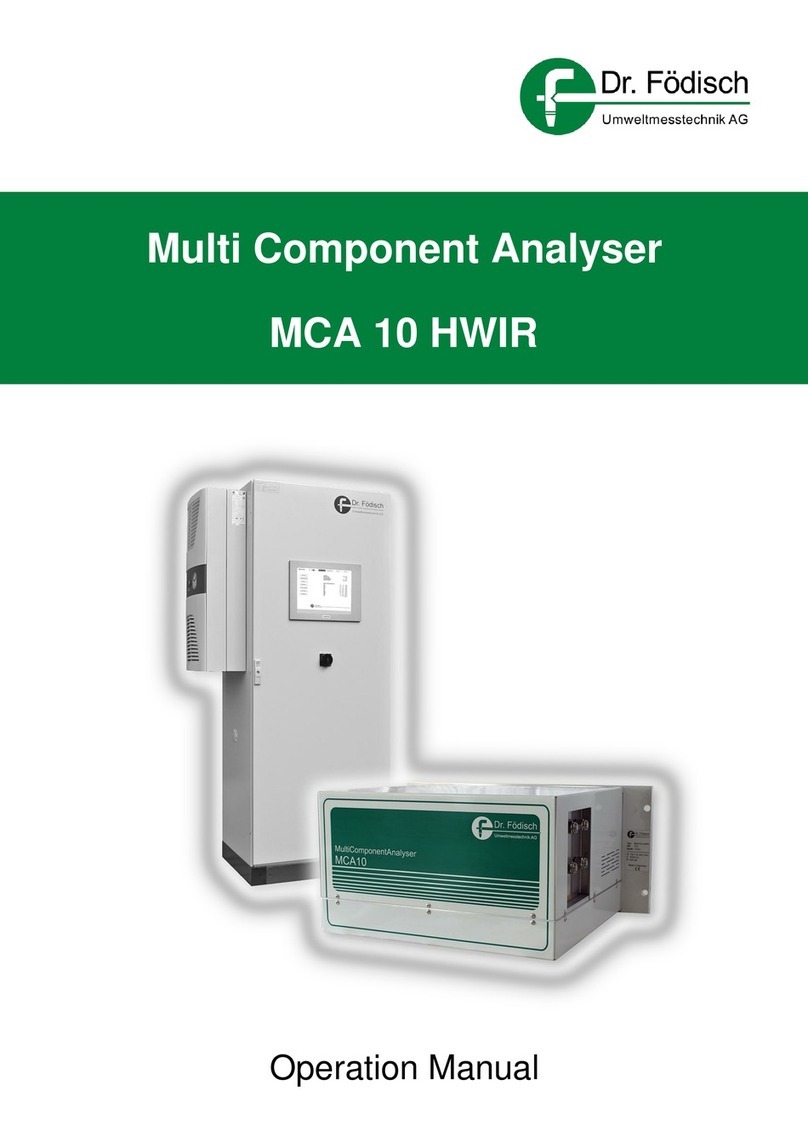
Dr. Födisch
Umweltmesstechnik
A
Page 4 of 78 Operation manual MGA 12 Version 1.3
6.1.2Measuring mode ..................................................................................................... 33
6.1.3Input mode .............................................................................................................. 33
6.2Operation ................................................................................................................ 34
6.2.1Keys ........................................................................................................................ 34
6.2.2Input ........................................................................................................................ 34
6.2.3Parameter input ...................................................................................................... 35
6.3Main menu .............................................................................................................. 36
6.3.1Setup....................................................................................................................... 36
6.3.1.1Setup | Integration................................................................................................... 37
6.3.1.2Setup | Outputs ....................................................................................................... 37
6.3.1.2.1Setup | Outputs | Output units................................................................................. 37
6.3.1.2.2Setup | Outputs | Output range ............................................................................... 38
6.3.1.2.3Setup | Outputs | Range change-over .................................................................... 39
6.3.1.2.4Setup | Outputs | Output limit values ...................................................................... 39
6.3.1.2.5Setup | Outputs | H3PO4 metering ......................................................................... 40
6.3.1.2.6Setup | Outputs | Probe back flushing (optionally).................................................. 40
6.3.1.2.7Setup | Outputs | Analogue outputs ........................................................................ 41
6.3.1.2.8Setup | Outputs | Analogue outputs | Output during AUTOCAL............................. 41
6.3.1.2.9Setup | Outputs | Analogue outputs | Output during MAINTENANCE.................... 41
6.3.1.2.10Setup | Outputs | Analogue outputs | Output during ERROR ............................ 42
6.3.1.3Setup | Digital inputs ............................................................................................... 42
6.3.1.3.1Setup | Digital inputs | Contact type........................................................................ 43
6.3.1.3.2Setup | Digital inputs | Trigger signal ...................................................................... 43
6.3.1.4Setup | Clock........................................................................................................... 44
6.3.1.4.1Setup | Clock | Set time........................................................................................... 44
6.3.1.4.2Setup | Clock | Set date .......................................................................................... 45
6.3.1.5Setup | Password.................................................................................................... 46
6.3.1.6Setup | Manual maintenance .................................................................................. 46
6.3.2Diagnosis ................................................................................................................ 46
6.3.2.1Diagnosis | Raw values........................................................................................... 47
6.3.2.2Diagnosis | Raw values absorption......................................................................... 47
6.3.2.3Diagnosis | Message archive.................................................................................. 47
6.3.2.4Diagnosis | Deviation values................................................................................... 47
6.3.2.4.1Diagnosis | Deviation values | Zero deviations ....................................................... 48
6.3.2.4.2Diagnosis | Deviation values | Cycle counter.......................................................... 48
6.3.2.4.3Diagnosis | Deviation values | Deviation limit ......................................................... 48
6.3.2.4.4Diagnosis | Deviation values | Reset deviation values ........................................... 48
6.3.2.5Diagnosis | Check outputs ...................................................................................... 49
6.3.2.5.1Diagnosis | Check outputs | Analogue outputs....................................................... 49
6.3.2.5.2Diagnosis | Check outputs | Digital outputs ............................................................ 50
6.3.2.5.3Diagnosis | Check outputs | MR outputs................................................................. 51
6.3.2.6Diagnosis | Export message archive ...................................................................... 52
6.3.2.7Diagnosis | Export parameter file............................................................................ 52
6.3.3Adjust ...................................................................................................................... 53
6.3.3.1Adjust | Automatic calibration.................................................................................. 53
6.3.3.1.1Adjust | Automatic calibration | Setup ..................................................................... 53
6.3.3.1.2Adjust | Automatic calibration | Setup | Zero purging gas....................................... 54
6.3.3.1.3Adjust | Automatic calibration | Setup | Zero purging times .................................... 54
6.3.3.1.4Adjust | Automatic calibration | Setup | Zero interval .............................................. 55
6.3.3.1.5Adjust | Automatic calibration | Setup | Zero point criterions .................................. 55
6.3.3.1.6Adjust | Automatic calibration | Setup | Reference purging times........................... 58
6.3.3.1.7Adjust | Automatic calibration | Setup | REF interval .............................................. 59
6.3.3.1.8Adjust | Automatic calibration | AUTOZERO now................................................... 59





























